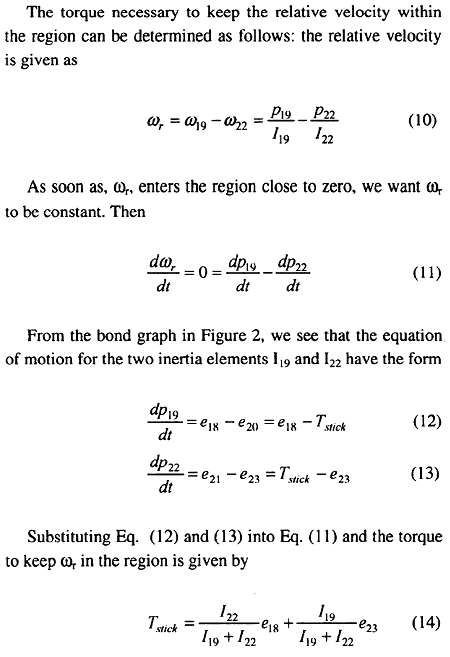Surrounding ωR=0 is defined a region of width 2ΔωR. When the relative velocity is inside this region the system "sticks" and with ωR outside this region the system "slips".
We adjust Tf=Tslip to assure that the relative velocity do not approach zero so fast that extremely small time steps are required for numerical integration. When the relative velocity reaches the shaded region near zero, we manipulate the torque in such a manner that the relative velocity is kept in this region.

Fig. 5. Bond Graph model of clutch.
This model provides a system structure that remains constant for each clutch state and the jump conditions after a clutching operation is take care of automatically. An attempt to reduce, Δωr, to zero will result in problems since, ωr, may jump over the region in one time step of simulation. The choice of a reasonable time step restricts the minimum value of, Δωr, and maximum, P(t). As in the real system, the clutch model only has one external input. P(t).
In selecting a proper engagement time, conflicting requirements occur:
・Short engagement times may cause large transient loadings.
・During engagement, energy is converted into thermal energy and consequently the frictional faces are subjected to a thermal load. The total amount of thermal energy produced during the slipping time can be computed from the integral of frictional power. Thus, short engagement times minimizes the thermal load.
The frictional, or thermal, energy can be computed from the following differential equation

As we have shown, the hydraulic pressure time history determines the clutch engagement time. Let us therefore look at an example of a hydraulic circuit for clutch engagement as shown schematically in Figure 6.
We will now illustrate the power of bond graphs by investigating two slightly different variations of the circuit shown in Figure 6. In the first case, we will look at the circuit as indicated in Figure 6. The bond graph for this case is shown in Figure 7.
Fig. 6. Hydraulic circuit.